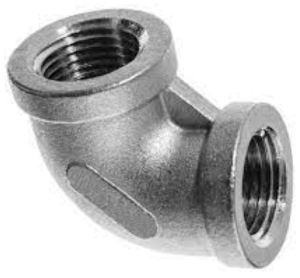Class 150 fittings are important parts of the complex web of industrial standards. These fittings are carefully designed and classified. They are important for seamless integration in different systems. Class 150 fittings are important for various uses. They can handle different pressure levels.
What is Class 150 Fitting?
Elbow – Male NPT (316 Stainless Steel-Class 150)
Class 150 fittings include various connectors, elbows, tees, and more. They are made for tough industrial environments. The term ‘Class 150′ means they work with systems that need a pressure rating of 150 psi.
Class 150 pipe fittings redirect flow in piping systems. They also connect equipment components. These fittings are mainly used to control low-pressure fluids or gasses. They are commonly used in non-critical situations where cost is important. Available in a size range from 1/8” to 4” (DN6 to DN100). They cater to a spectrum of needs within diverse industrial contexts.
What Does 150 Mean in Pipe?
The number ’150′ has significance in relation to pipes. It translates into a pressure rating. The numerical designation represents the maximum pressure in pounds per square inch. This pressure is the limit that a pipe or fitting can handle. Class 150 pipes can handle up to 150 psi, making them suitable for various industries.
Engineers and professionals must understand numbers. They use this knowledge to select the appropriate pipes for a system.
The Role of Class 150 in Engineering
Class 150 is an important part of engineering that combines functionality and reliability. These fittings are important for engineering. They help fluid systems work well in different pressures and conditions. Class 150 is important for keeping things working well, like machines and pipelines.
Engineers use Class 150 fittings to meet industry standards in system design. Class 150 components are adaptable and precise. They make engineering solutions strong in various sectors.
Compliance and Certification
To understand industrial standards, you need to focus on compliance and certification. Class 150 fittings follow strict guidelines. They go through rigorous testing to meet the standards. Certification processes check if things are strong, made well, and can handle pressure.
Following industry standards makes Class 150 fittings reliable. It also promotes safe engineering practices. Certifications show that these components are high quality and perform well. This gives confidence in their use.
Challenges in Implementing Class 150
Class 150 fittings have many benefits. However, they also come with challenges during implementation. Engineers must navigate hurdles due to industry-specific nuances and evolving technologies. These hurdles arise from varying application demands. In order to use Class 150 components in different industries, we need to address these challenges.
Engineers face challenges when adding Class 150 fittings. They must match materials and follow rules. Overcoming these challenges demands a holistic approach, blending expertise, innovation, and adaptability.
Also, read↘️↘️↘️:
➡️ BS5200 Standard: Ensuring Quality And Safety
➡️ Hydraulic Pipe Pressure: Unraveling The PSI Mystery
➡️ Class 3000 Fittings 101: The Ultimate Guide To Robust Connections
Key Takeaways
Class 150 is an important part of industrial standards. It is known for being precise, reliable, and adaptable. Professionals in fluid systems need to understand Class 150 fittings. These fittings have numeric significance and play a role in engineering marvels.
As we look at industrial standards, Class 150 shows parts made to handle pressure in various uses. Each part of Class 150 adds to its global impact on engineering. This includes following rules and facing difficulties.
Post time: Jan-08-2024


